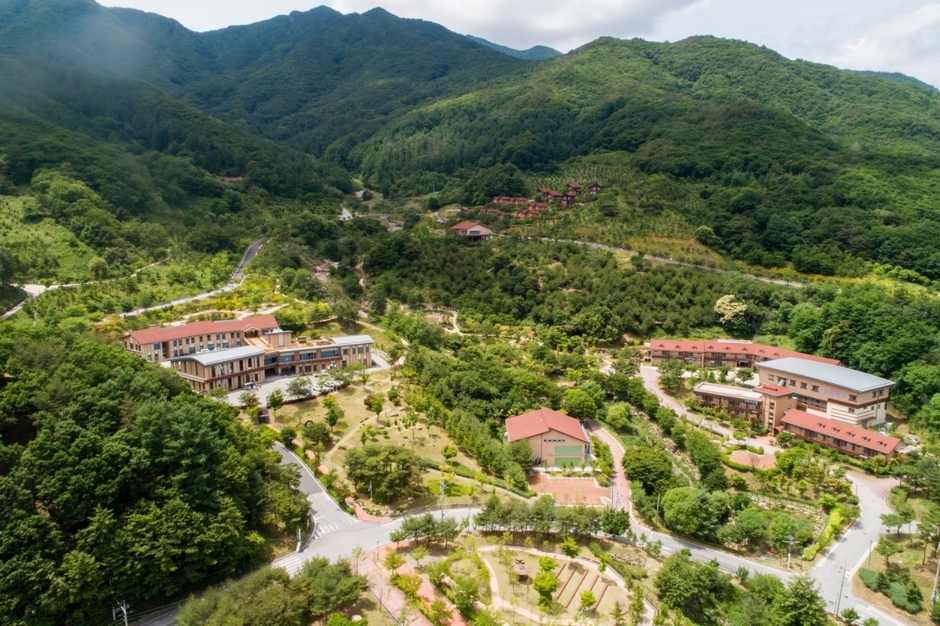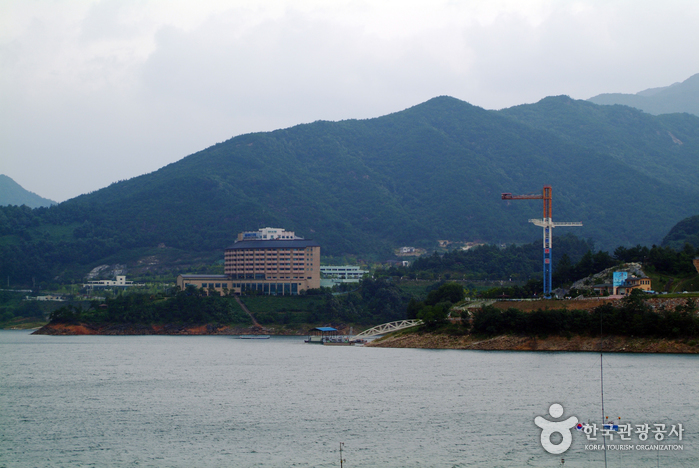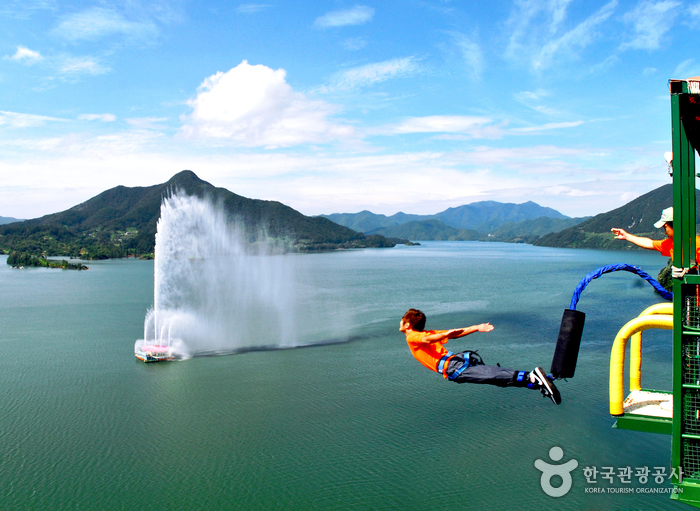National Center for Forest Therapy (국립산림치유원)
16.5Km 2025-10-23
209 Therapy-ro, Bonghyeon-myeon, Yeongju-si, Gyeongsangbuk-do
The National Center for Forest Therapy is a forest-themed well-being complex created to promote public health and quality of life by leveraging the abundant forest resources of the Baekdudaegan Mountain Range. Forests have transformed into a destination for healing one's mind and body, as well as a place for recreation. The National Center for Forest Therapy provides guidelines for proper exercise and daily habit improvements aimed at relieving stress and promoting mental and physical balance by utilizing the healing properties of the forest. Furthermore, visitors can experience the effects of forest therapy here. The center has healing forest trails, recreational facilities, accommodation facilities, and others.
Cheongpung Land (청풍랜드)
16.7Km 2025-07-09
San 26, Gyo-ri, Cheongpung-myeon, Jecheon-si, Chungcheongbuk-do
+82-43-648-4151
Cheongpung Land est un parc de loisir créé en 2002 près du lac de Cheongpunghoban (lac de Chungjuho à Cheongpung-myeon, Jecheon-si dans la province du Chungcheongbuk-do. Le parc accueille trois attractions pleines de sentations fortes : une tour de saut à l’élastique haute de 62 mètres, le tout premier siège éjectable de Corée et « Big Swing », une expérience à gravité nulle. On peut également y admirer des geysers d’eau jaillissant à 162 mètres dans l’air, ainsi qu’une vue panoramique sur le paysage environnant.
Le parc est l’une des plus grandes attractions touristiques de la région, et se trouve non loin d’autres destinations populaires, comme le site de tournage du drama historique de KBS « Daejo Wangeon », le mont Geumsusan et le parc national de la montagne Woraksan.
Cheongpung Land (청풍랜드)
16.8Km 2024-07-02
6, Cheongpungho-ro 50-gil, Jecheon-si, Chungcheongbuk-do
Cheongpung Land was created in 2002 near Chungjuho Lake in Cheongpung-myeon, Jecheon-si, Chungcheongbuk-do. It features beautiful scenery and the maximum use of practical space to build Korea’s first multi-tower. Based on planning, constructing, and test runs, it is operated by Over Class Inc. which is cosigned by Jecheon-si. The multi-tower’s three main facilities are a 62-meter Bungee Jump, Korea’s first-ever Ejection Seat, and Big Swing. The bungee jump highlights safety by adding a safety line to the gear to prevent falling accidents caused by breaking of the bungee cord rubber.
Cheongpung Cultural Heritage Complex (청풍문화재단지)
17.3Km 2022-12-26
2048, Cheongpungho-ro, Jecheon-si, Chungcheongbuk-do
+82-43-641-5532
Cheongpung Cultural Heritage Complex in Jecheon, Chungcheongbuk-do contains a variety of cultural heritages and artifacts that were collected from the region before it was flooded in 1985 during the construction of Chungju Dam. Here, visitors can see Hanbyeongnu Pavilion (Treasure), Stone Standing Buddha (Treasure), Paryeongnu Pavilion, Geumnamnu Pavilion, Geumbyeongheon Hall, Eungcheonggak Pavilion and the Cheongpunghyanggyo Local Confucian School as well as nearly 2,000 household artifacts. It has become an outdoor museum of the glorious culture of the upper reaches of the Namhangang River.
Neutinamu Hoetjip (느티나무횟집)
17.6Km 2024-03-25
4 Baesiron-ro, Cheongpung-myeon, Jecheon-si, Chungcheongbuk-do
+82-43-647-0089
Neutinamu Hoetjip is a distinguished Korean restaurant situated within Cheongpungho Bibimbap Town. Its standout dish is songeo bibimhoe (spicy raw trout salad with vegetables). The salad highlights the freshness of sliced raw trout, enriched with a mix of powdered soybean, perilla leaves, sesame oil, and cucumber for a unique blend of flavors and textures. Beyond this signature dish, Neutinamu Hoetjip offers an array of local specialties featuring freshwater fish. Their sutbul maneul tteokgalbi (charcoal-grilled garlic and galbi patties) and ssogari maeuntang (spicy mandarin fish stew) are also popular choices among patrons.
Cheongpung Cable Car (청풍호반케이블카)
17.6Km 2024-07-31
166 Munhwajae-gil, Jecheon-si, Chungcheongbuk-do
Cheongpung Cable Car takes passengers back and forth between Multae-ri in Cheongpung-myeon and Bibongsan Mountain along a 2.3-kilometer ropeway. There are a total of 43 cabins that accommodate up to 10 passengers per car, with ten cabins featuring transparent flooring to offer a thrilling bird's-eye-view of Cheongpung-myeon. The cable car can reach a maximum speed of 5 meters per second and takes around 10 minutes from the departure point to Bibongsan Mountain peak. Bibongsan Mountain sits at the center of Cheongpungho Lake and has an elevation of 531 meters. The sight from top offers a feeling as if one is looking down at an archipelago. The cable car allows children and the elderly to enjoy the sight without the hassle of hiking up to the summit.
Sobaeksan National Park (Gyeongsangbuk-do Region) (소백산국립공원(경북))
17.8Km 2023-02-17
Punggi-eup, Yeongju-si, Gyeongsangbuk-do
+82-54-638-6196
Sobaeksan National Park was designated as the 18th national park in December 1987. The features of Sobaeksan National Park include wildflowers and royal azaleas in spring and snowy scenery in winter. The mountain borders three provinces and four cities. Attractions include various peaks, temples, and waterfalls. The mountain is especially popular in May when royal azaleas are in full bloom and a natural forest tunnel is formed. Birobong Peak of the mountain is covered with snow six months of the year and is called the Alps of Korea.
Yeongju Punggi Insam Festival (경북영주 풍기인삼축제)
18.6Km 2025-07-11
Seongnae-ri, Punggi-eup, Yeongju-si, Gyeongsangbuk-do
+82-54-639-6612
Ginseng is a well-known traditional Korean medicinal herb. High quality ginseng in Korea is mostly produced in Punggi, a region in Yeongju, Gyeongsangbuk-do, and the place where the Punggi Ginseng Festival takes place. The festival features health-related exhibits and offers opportunities to taste healthy ginseng dishes at the ginseng cooking exhibition. Visitors can also participate in Punggi ginseng-related interesting activities such as making Punggi ginseng wine and peeling ginseng in the traditional Korean way. The festival offers a variety of ginseng products, including fresh ginseng, original ginseng, red ginseng, and ginseng processed foods, which are all grown by local farmers in Yeongju and sold at reasonable prices. Additionally, the festival showcases local specialties and symbols such as ginseng and Yeongju apples through oil lantern displays along Namwoncheon Stream. With so many attractions, visitors are sure to have a great time at the festival.
Bapsang Wiui Boyak Hancheop (밥상위의보약한첩 청풍)
18.9Km 2024-03-25
40 Baesiron-ro, Cheongpung-myeon, Jecheon-si, Chungcheongbuk-do
+82-43-647-0065
Bapsang Wiui Boyak Hancheop is a notable restaurant located near the Multae-ri cable car station, renowned for its dedication to serving traditional Jecheon dishes. The restaurant is particularly famous for offering side dishes prepared with local specialties such as deodeok and various types of namul. Its flagship offering, the Boyak Hancheop, is a grilled marinated eel set menu. The restaurant has garnered significant acclaim, having won the Grand Prize in the Chungbuk Traditional Cuisine Contest. Nearby attractions such as the scenic Chungjuho Lake and the Cheongpung Cultural Heritage Complex enhance the dining experience with cultural enrichment and natural beauty.
Geumwolbong Peak (금월봉)
19.7Km 2024-02-26
1316 Cheongpungho-ro, Geumseong-myeon, Jecheon-si, Chungcheongbuk-do
Geumwolbong Peak is a unique, small rocky mountain distinguished by its diverse shapes that blend a touch of artificiality with natural beauty. This site, initially a limestone mine, unveiled its striking rock formations in 1993. The resemblance of these rocks to the Manmulsang (Ten Thousand Rocks) of North Korea's Geumgangsan Mountain earned it the nickname "Little Geumgangsan Mountain." It was later officially renamed Geumwolbong Peak.







 English
English
 한국어
한국어 日本語
日本語 中文(简体)
中文(简体) Deutsch
Deutsch Français
Français Español
Español Русский
Русский